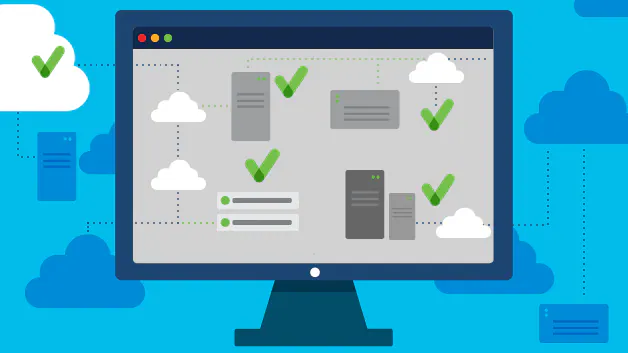The Simple Guide to Server Uptime Monitoring: Keeping Your Digital World Spinning
Discover the secrets of server uptime monitoring and learn how to keep your digital services running smoothly 24/7. Explore cutting-edge tools, best practices, and expert strategies for minimizing downtime and maximizing performance.
Posted by
 Sabyr Nurgaliyev
Sabyr Nurgaliyev
Introduction: The Heartbeat of Your Digital Empire
Picture this: You're the ruler of a vast digital empire. Your websites, apps, and online services are the lifeblood of your kingdom. But what happens when the heart of your empire – your servers – skip a beat? Chaos ensues, subjects (aka users) revolt, and your digital realm crumbles faster than you can say "server crash."
Enter the unsung heroes of the digital world: server uptime monitoring tools. These tireless guardians work round the clock to ensure your digital kingdom runs smoothly, keeping the dreaded downtime dragon at bay. But how exactly do they work their magic? And more importantly, how can you harness their power to fortify your own digital domain?
Buckle up, dear reader, because we're about to embark on an epic journey through the land of server uptime monitoring. By the time we're done, you'll be armed with the knowledge to keep your digital world spinning, no matter what cyber storms may come your way.
The ABCs of Server Uptime: What's the Big Deal?
Alright, let's start with the basics. What exactly is server uptime, and why should you care? Well, imagine you're running a brick-and-mortar store. Server uptime is like keeping your store open during business hours. If your store is closed when customers come knocking, you're losing business faster than a melting ice cream cone on a hot summer day.
In the digital world, server uptime refers to the amount of time your servers (and by extension, your websites and services) are up and running. It's usually measured as a percentage, with the holy grail being the elusive "five nines" or 99.999% uptime. That might sound impressive, but even that allows for about 5 minutes of downtime per year!
But why is uptime such a big deal? Let's break it down:
*Lost Revenue: For e-commerce sites, every minute of downtime is like setting fire to a pile of cash. According to Gartner, the average cost of IT downtime is $5,600 per minute. Ouch!
*Damaged Reputation: In the age of social media, news of your site being down spreads faster than gossip in a small town. Users are quick to jump ship to competitors if they can't access your services.
*SEO Penalties: Search engines like Google don't take kindly to sites that are frequently down. Poor uptime can hurt your search rankings, making it harder for users to find you in the first place.
*Productivity Loss: If you're running internal business systems, downtime can bring your entire operation to a screeching halt. Imagine trying to work without access to your company's cloud services or databases. It's like trying to drive a car with no wheels!
So, how do you keep tabs on your server uptime and nip potential issues in the bud? That's where network uptime monitors come in handy. These digital watchdogs keep a constant eye on your servers, alerting you at the first sign of trouble. It's like having a team of tireless security guards patrolling your digital premises 24/7.
The Anatomy of a Network Uptime Monitor: How Does It Work?
Now that we've established why server uptime is crucial, let's dive into the nitty-gritty of how network uptime monitors actually work. It's not magic (although sometimes it might seem like it), but rather a clever combination of technology and strategy.
At its core, a network uptime monitor works by regularly sending requests to your servers from various locations around the world. These requests, often called "pings," are like little digital knocks on your server's door. If the server answers promptly, all is well. If it doesn't... well, that's when the alarms start blaring.
But modern uptime monitors do much more than just check if your server is alive. They're like Swiss Army knives for your digital infrastructure, packed with features to keep your online presence running smoothly. Let's take a closer look at some of these features:
Response Time Monitoring
It's not enough for your server to just be "up." It needs to be responsive too. Uptime monitors measure how long it takes for your server to respond to requests. If your server starts taking longer to respond than a teenager asked to do chores, your monitor will let you know it's time for some optimization.
Content Checks
What if your server is up, but it's serving the wrong content? Maybe your homepage has been replaced by a picture of a cat (cute, but not great for business). Advanced uptime monitors can check for specific content on your pages to ensure everything is as it should be.
SSL Certificate Monitoring
In today's security-conscious world, having a valid SSL certificate is crucial. Uptime monitors can keep an eye on your SSL certificates, alerting you well before they expire. It's like having a personal assistant to remind you to renew your digital driver's license.
Multi-Location Monitoring
Your website might be lightning-fast for users in New York, but what about those in Tokyo or Sydney? Good uptime monitors check your site from multiple locations around the world, ensuring a consistent experience for all your users, no matter where they are.
Real User Monitoring (RUM)
Some advanced monitors don't just simulate user behavior – they actually track how real users interact with your site. This gives you valuable insights into performance issues that might not show up in synthetic tests.
Integration with Other Tools
Modern uptime monitors play well with others. They can integrate with your existing tools, sending alerts to your team chat, automatically creating support tickets, or even triggering automated responses to certain issues.
By now, you're probably thinking, "Wow, these uptime monitors sound amazing! But how do I choose the right one for my needs?" Well, dear reader, that's exactly what we're going to cover in our next section. So grab a fresh cup of coffee (or tea, if that's your jam), and let's dive into the world of choosing the perfect uptime service for your digital kingdom.
Choosing the Perfect Uptime Service: A Buyer's Guide
Alright, so you're convinced that you need an uptime service. (If you're not, go back and read the last two sections again. I'll wait.) But with more options out there than flavors in an ice cream shop, how do you choose the right one for your needs? Don't worry, I've got your back. Here's your comprehensive buyer's guide to uptime services:
Know Thyself (and Thy Servers)
Before you start shopping around, take a moment to think about what you actually need. Are you running a small blog, or a large e-commerce empire? Do you need basic ping checks, or advanced performance analytics? Make a list of your must-have features. It's like making a shopping list before hitting the grocery store – it keeps you focused and prevents impulse buys.
Key Features to Look For
When evaluating different uptime services, keep an eye out for these important features:
- Real-time alerts: Because you need to know about problems ASAP, not next week.
- Customizable check intervals: How often do you want your servers pinged?
- Multiple check locations: To ensure your site works well globally, not just in your backyard.
- Detailed reporting: Because data is power, and pretty graphs are nice too.
- Integration capabilities: Can it play nice with your other tools?
- User-friendly interface: Because ain't nobody got time for a PhD in uptime monitoring.
Show Me the Money: Pricing Considerations
Uptime services come in all shapes and sizes, from free basic plans to enterprise-level solutions that cost more than your first car. Consider your budget, but remember – sometimes it's worth investing a bit more for peace of mind and robust features. After all, how much is an hour of downtime costing you?
Support When You Need It
When your server decides to take an unscheduled vacation at 2 AM, you want to know you can get help fast. Look for providers that offer 24/7 support, and check out their response times and customer reviews. It's like choosing a friend – you want someone who'll be there for you in the middle of the night, not just during business hours.
Try Before You Buy
Many uptime services offer free trials. Take advantage of these to test drive different tools and see which one feels right for your needs. It's like dating – you wouldn't marry someone after the first date, would you? (If you would, we need to have a different conversation...)
Setting Up Your Uptime Monitoring: A Step-by-Step Guide
Congratulations! You've chosen your uptime service. Now what? Don't worry, I've got your back. Here's a step-by-step guide to getting your monitoring set up:
Step 1: Sign Up and Log In
Okay, this one's pretty self-explanatory. Sign up for your chosen service and log in to your shiny new dashboard. It's like getting the keys to your new digital car – exciting, right?
Step 2: Add Your Servers
Most tools will have an option to "Add a new monitor" or "Add a new server." Click that and enter your server's details. This usually includes the URL or IP address, and possibly some authentication details if you're monitoring private servers.
Step 3: Choose Your Check Types
Depending on your tool, you might have options like:
- Ping checks: Basic "are you alive?" checks.
- HTTP(S) checks: More detailed checks that actually load a web page.
- TCP checks: For monitoring specific ports or services.
- DNS checks: To ensure your domain is resolving correctly.
Choose the types that make sense for your setup. It's like choosing toppings for your pizza – pick what you like, leave off what you don't need.
Step 4: Set Your Check Frequency
How often do you want your servers checked? Every minute? Every 5 minutes? Every hour? The more frequent the checks, the faster you'll know about any issues – but it might also cost more. Find the balance that works for you.
Step 5: Configure Your Alerts
Decide how you want to be notified when something goes wrong. Email? SMS? Carrier pigeon? (Okay, maybe not that last one.) You might also want to set up escalation procedures for serious issues. It's like setting up your phone's ringtones – make sure the important calls (or in this case, alerts) get through.
Step 6: Set Up Integrations
If your uptime service integrates with other tools you use (like Slack or PagerDuty), now's the time to set those up. It's like introducing your new friend to your existing friend group – the more they get along, the better.
Step 7: Customize Your Dashboard
Arrange your dashboard so you can see the most important information at a glance. Most tools allow you to create custom views or widgets. Make it work for you – after all, you're the one who's going to be looking at it.
Step 8: Test Your Setup
Don't just assume everything's working – test it out! You might even want to intentionally cause a problem (like temporarily taking a server offline) to make sure your alerts are working correctly. It's like a fire drill for your servers – better to practice now than to be caught off guard later.
Best Practices for Effective Uptime Monitoring
Now that you've got your uptime monitoring set up, let's talk about how to use it effectively. Here are some best practices to keep in mind:
Don't Overdo the Alerts
It's tempting to set up alerts for every little thing, but resist the urge. Too many alerts can lead to alert fatigue, where you start ignoring notifications because there are just too many. It's like the boy who cried wolf – if everything is an emergency, nothing is. Focus on the truly important stuff.
Regularly Review Your Reports
Don't just wait for alerts – make a habit of regularly reviewing your monitoring reports. This can help you spot trends and potential issues before they become big problems. It's like getting regular check-ups at the doctor – prevention is better than cure.
Keep Your Monitoring Up to Date
As your infrastructure evolves, make sure your monitoring evolves with it. Regularly review and update your monitoring settings to ensure you're tracking everything that matters. It's like updating your phone's software – keep it current to get the best performance.
Use Status Pages
Consider setting up a public status page to keep your users informed about any issues or scheduled maintenance. It's like putting up a "Back in 5 minutes" sign on your store – it keeps your customers in the loop and shows you're on top of things.
Monitor from Multiple Locations
If you have a global audience, make sure you're monitoring your servers from different geographic locations. What works well in New York might not work so well in New Delhi. It's like having eyes and ears all over the world.
Set Realistic Thresholds
When setting up performance thresholds, be realistic. While it's great to aim for lightning-fast response times, setting your alert threshold too low will just result in a lot of false alarms. It's like setting your alarm clock – you want it to wake you up when needed, not every five minutes.
Have a Response Plan
Don't wait for something to go wrong to figure out how you'll handle it. Have a clear plan in place for different types of issues, including who's responsible for what. It's like having a fire escape plan – you hope you'll never need it, but you'll be glad you have it if you do.
Common Uptime Monitoring Mistakes (and How to Avoid Them)
Even with the best intentions, it's easy to make mistakes when it comes to uptime monitoring. Here are some common pitfalls to watch out for:
Mistake #1: Monitoring Only from One Location
If you're only monitoring from one location, you might miss issues affecting users in other parts of the world. Make sure you're monitoring from multiple geographic locations to get a true picture of your global performance.
Mistake #2: Ignoring Partial Outages
Not all outages are total. Sometimes, only certain features or pages might be affected. Make sure your monitoring is granular enough to catch these partial outages.
Mistake #3: Neglecting Internal Services
If your business relies on internal services or APIs, make sure you're monitoring those too. An issue with an internal service can impact your external-facing sites just as much as a problem with your public servers.
Mistake #4: Failing to Act on Data
Monitoring is only useful if you actually do something with the information it provides. Make sure you have processes in place to address issues and implement improvements based on your monitoring data.
Mistake #5: Overlooking Security Monitoring
Don't forget about security! In addition to uptime and performance, make sure you're monitoring for potential security threats and vulnerabilities.
The Future of Uptime Monitoring: What's Next?
As we wrap up our deep dive into uptime monitoring, let's take a moment to look ahead. What does the future hold for this crucial aspect of IT management? Here are some trends to watch:
AI and Machine Learning
Artificial Intelligence and Machine Learning are set to revolutionize uptime monitoring. These technologies can help predict issues before they occur, automatically diagnose problems, and even suggest solutions. It's like having a crystal ball for your servers!
Increased Focus on User Experience
While traditional metrics like uptime and response time will always be important, we're likely to see an increased focus on monitoring the overall user experience. This might include things like tracking user journeys, analyzing interaction patterns, and measuring engagement metrics.
Integration with DevOps Practices
As DevOps practices become more widespread, we'll likely see closer integration between uptime monitoring tools and development workflows. This could lead to faster issue resolution and more proactive performance optimization.
Enhanced Security Monitoring
With cyber threats becoming increasingly sophisticated, uptime monitoring tools are likely to incorporate more advanced security features. This might include things like real-time threat detection and automated vulnerability assessments.
IoT and Edge Computing Monitoring
As the Internet of Things (IoT) grows and edge computing becomes more prevalent, uptime monitoring will need to adapt to these new paradigms. We might see tools designed specifically for monitoring IoT devices or edge computing nodes.
Conclusion: Your Servers' New Best Friend
And there you have it, folks! We've journeyed through the world of uptime monitoring, from understanding its importance to implementing best practices and looking towards the future. Remember, in today's digital landscape, your servers are the backbone of your online presence. Uptime monitoring is like having a trusty sidekick, always there to ensure your digital infrastructure is running at its best.
So, are you ready to take your server management to the next level? With the right uptime monitoring tools and strategies in place, you'll be well on your way to providing a reliable, high-performance experience for your users. Don't let your servers be lone wolves in the vast digital wilderness. Give them the support they deserve with robust uptime monitoring.
Remember, the internet never sleeps, and neither should your uptime monitoring. So go forth, implement toring. So go forth, implement these strategies, and watch your digital empire thrive!
FAQs: Your Burning Questions Answered
Still have questions? Don't worry, I've got you covered. Here are answers to some frequently asked questions about uptime monitoring:
Q: How often should I check my server uptime?
A: The frequency of checks depends on your specific needs, but most experts recommend checking at least every 5 minutes for critical services. Less critical services might be fine with checks every 15-30 minutes.
Q: Can uptime monitoring slow down my servers?
A: No, properly implemented uptime monitoring should have negligible impact on your server performance. Most monitoring tools use lightweight requests that don't significantly increase server load.
Q: What's the difference between synthetic and real user monitoring?
A: Synthetic monitoring simulates user behavior to test your servers, while real user monitoring collects data from actual user interactions. Both have their place – synthetic monitoring provides consistent, controlled tests, while real user monitoring gives you insights into actual user experiences.
Q: How much does uptime monitoring cost?
A: Costs vary widely depending on the service and features you need. Basic plans can start as low as $10/month, while enterprise-level solutions can cost hundreds or thousands per month. Many providers offer free trials, so you can test before committing.
Q: Can I monitor multiple servers with one service?
A: Yes, most uptime monitoring services allow you to monitor multiple servers from a single dashboard. This can be especially useful for businesses managing complex infrastructures.
Q: What should I do if my monitoring tool detects an issue?
A: First, verify the issue to ensure it's not a false alarm. Then, follow your incident response plan to address the problem. This might involve notifying your IT team, implementing a fix, or rolling back recent changes. Always communicate with affected users and stakeholders.
The Last Word: Your Servers' Health is Your Business's Wealth
As we wrap up this deep dive into the world of uptime monitoring, let's take a moment to reflect on why all of this matters. In today's digital-first world, your servers aren't just machines humming away in a data center – they're the beating heart of your online presence. They're where your websites live, where your applications run, and often where your business's most valuable data resides.
Think about it: when was the last time you stuck around on a slow or unreliable website? Probably never. Your users are no different. They expect your services to be available and responsive 24/7, 365 days a year. Uptime monitoring is your secret weapon in meeting (and exceeding) those expectations.
But it's not just about keeping your users happy (although that's a pretty big deal). Effective uptime monitoring can also:
- Save you money: By catching and fixing issues before they become major problems, you can avoid costly downtime and lost revenue.
- Boost your reputation: Reliable services lead to happy users, and happy users lead to positive word-of-mouth and brand loyalty.
- Improve your decision-making: The data you get from uptime monitoring can help you make informed decisions about everything from server upgrades to capacity planning.
- Give you peace of mind: With a good monitoring system in place, you can rest easy knowing that someone (or something) is always keeping an eye on your digital infrastructure.
So, as you go forth into the wild world of server management, remember: your servers' health is your business's wealth. Treat them well, keep a watchful eye on them, and they will repay you many times over.
Now, it's your turn. What steps will you take to implement or improve your uptime monitoring? How will you use the insights you gain to take your digital infrastructure to the next level? The digital world is waiting – go out there and make your mark!
And remember, in the ever-changing landscape of technology, staying informed is key. Keep learning, keep adapting, and most importantly, keep monitoring. Your servers (and your bottom line) will thank you.
Happy monitoring, and here's to your online success! 🚀
For more information on server monitoring and best practices, you might want to check out Debugbear's comprehensive guide on website monitoring. While they're a competitor, their resource provides valuable insights that complement what we've discussed here.
Related Articles

Dive into the world of uptime services, downtime monitors, and network vigilance. Learn how to keep your servers running smoothly and your digital presence thriving in an always-on world.
 Sabyr NurgaliyevSep 8, 2024
Sabyr NurgaliyevSep 8, 2024
Dive into the world of uptime services, downtime monitors, and network vigilance. Learn how to keep your digital presence thriving 24/7 and why every second counts in the online realm.
 Sabyr NurgaliyevSep 7, 2024
Sabyr NurgaliyevSep 7, 2024
Dive into the world of uptime services and downtime monitors. Learn how to keep your servers running smoothly, maximize network uptime, and choose the right tools for your business.
 Sabyr NurgaliyevSep 6, 2024
Sabyr NurgaliyevSep 6, 2024
Discover how website monitoring apps, network uptime monitors, and uptime services ensure your online presence remains uninterrupted. Learn about the importance of downtime monitoring and server uptime.
 Sabyr NurgaliyevAug 21, 2024
Sabyr NurgaliyevAug 21, 2024
Discover the top tools and strategies to keep your network and servers running smoothly, and learn how to minimize downtime.
 Sabyr NurgaliyevSep 4, 2024
Sabyr NurgaliyevSep 4, 2024
A deep dive into the world of network uptime monitors, downtime monitors, and server uptime. Discover how to keep your website online and your business thriving.
 Sabyr NurgaliyevAug 27, 2024
Sabyr NurgaliyevAug 27, 2024